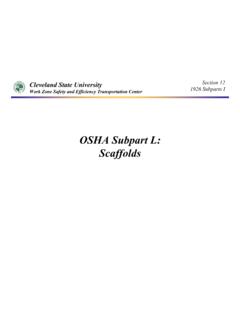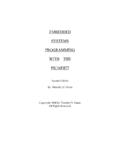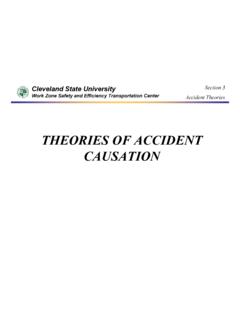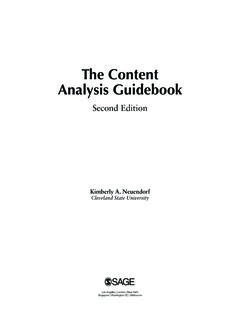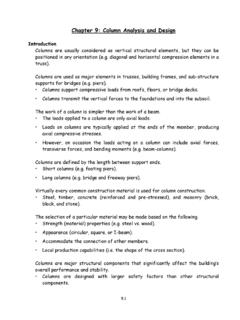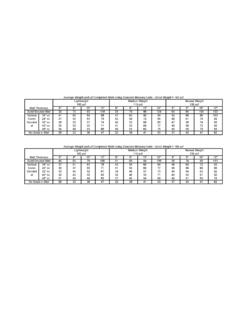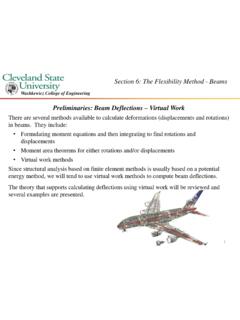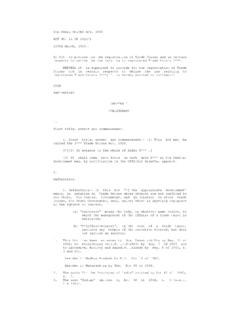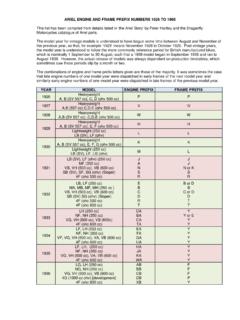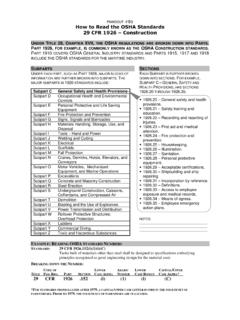Transcription of OSHA 1926 Subpart D Occupational Health & …
1 Section 91926 Subparts D & ECleveland State UniversityWork Zone Safety and Efficiency Transportation CenterOSHA 1926 Subpart DOccupational Health & Environmental ControlsSection 91926 Subparts D & ECleveland State UniversityWork Zone Safety and Efficiency Transportation Medical Services and First AidMedical services(a) must be available for advice and consultation(b) provide for prompt medical attention for injuries before construction work begins(c) If medical services are not reasonably accessible (time and distance) for treatment of injuries, a person on site must have a first aid certificate(d) First aid supplies (1) easily accessible when required (2) contents in individual sealed packages, and inventory checked before being sent to the job and checked weekly thereafterSection 91926 Subparts D & ECleveland State UniversityWork Zone Safety and Efficiency Transportation Medical Services and First Aid(f) If 911 is not available post telephone numbers of a physicians, hospitals or ambulances(g) If the eyes or body are exposed to corrosive materials, provide facilities to quickly drench or flush the eyes and body in the work areaSection 91926 Subparts D & ECleveland State UniversityWork Zone Safety and Efficiency Transportation Sanitation(a) Potable Water(1) Adequate supply must be provided(2) Containers can be closed and equipped with a tap.
2 No dipping into the water.(3) Containers clearly marked and used for no other purpose(4) No common drinking cups(5) Paper cups have sanitary dispensers for fresh cups and receptacle for used cupsSection 91926 Subparts D & ECleveland State UniversityWork Zone Safety and Efficiency Transportation Sanitation (continued)(b) Nonpotable Water(1) Outlets shall be clearly marked that water is unsafe for drinking, washing, or cooking(c) Toilets20 workers or less 1 needed21 to 199 workers 1 toilet seat & 1 urinal per 40 workers200 or more 1 toilet seat & 1 urinal per 50 workers(f) Washing Facilities(1) Adequate washing facilities must be provided for workers engaged in the application of paints, coating, herbicides, or insecticides, or where other contaminants are used. Facilities must be near to the worksite and adequately 91926 Subparts D & ECleveland State UniversityWork Zone Safety and Efficiency Transportation Sanitation (continued)(3) Lavatories (i) Required at all places of employment.
3 This does not apply to mobile crews if workers have transportation to nearby washing facilities (ii) shall be hot and cold running water or tepid running water (iii) Hand soap or other cleansing agent to be provided (iv) Provide either: individual hand towels (cloth or paper)warm air blowersclean continuous cloth towelingSection 91926 Subparts D & ECleveland State UniversityWork Zone Safety and Efficiency Transportation Occupational Noise Exposure(a) Noise exposure must be limited to acceptable levels in terms of decibels and duration90 db 8 hours95 db 4 hours100 db 2 hours110 db 1/2 hourSection 91926 Subparts D & ECleveland State UniversityWork Zone Safety and Efficiency Transportation Nonionizing Radiation(a) only qualified employees assigned to install, adjust, and operate laser equipment.(b) operator to carry proof of certification(c) warning placards telling of laser use(g) never direct laser beams on employees(h) lasers not used in rain, snow, dust, 91926 Subparts D & ECleveland State UniversityWork Zone Safety and Efficiency Transportation Gases, Vapors, Fumes, Dusts & MistsExposure to inhalation, ingestion, skin absorption, or contact with any material or substance above the Threshold Limit Values of Airborne Contaminants shall be Illumination(a) table D-3 specifies the minimum illumination intensities in foot-candles.
4 Most construction areas to have at least 5 foot candles of Ventilation(a) When dusts, fumes, mists, vapors, or gases are in the air, their concentrations shall not exceed the threshold limit values for the particular materials. Ventilation of the area is advised and should conform to the OSHA 91926 Subparts D & ECleveland State UniversityWork Zone Safety and Efficiency Transportation CenterOSHA 1926 Subpart EPersonal Protective & Life Saving EquipmentSection 91926 Subparts D & ECleveland State UniversityWork Zone Safety and Efficiency Transportation CenterPersonal Protective Equipment (PPE)and High Visibility ClothingObjectives: Recognize Requirements for PPE Recognize Relevant OSHA Standards Recognize Main Components of the Respiratory Standard Recognize Method for Selecting Appropriate Respiratory Protection Recognize Importance of High Visibility Apparel and Classes of GarmentsSection 91926 Subparts D & ECleveland State UniversityWork Zone Safety and Efficiency Transportation CenterPPE and Worker ProtectionAccording to federal data.
5 Of all the workers who suffer head injuries, only 16% wear hard hats Only 1% of those suffering face injures wore face protection Only 23% of those workers with foot injuries wear safety shoes or boots, and About 40% of those suffering eye injuries wear eye protective equipmentSection 91926 Subparts D & ECleveland State UniversityWork Zone Safety and Efficiency Transportation CenterManagement ResponsibilitiesIt is management s responsibility to develop an in-depth evaluation of the equipment needed to protect against the hazards at the workplaceIn addition management is required to develop: operating procedures employee training covering use, maintenance, and cleaning of equipmentSection 91926 Subparts D & ECleveland State UniversityWork Zone Safety and Efficiency Transportation CenterEncouraging Use of PPEE mployees must understand their Health and lives may depend upon the correct use of must be aware that the equipment does not eliminate the hazard.
6 If the equipment fails, exposure will reduce the possibility of failure, equipment must be properly fitted and 91926 Subparts D & ECleveland State UniversityWork Zone Safety and Efficiency Transportation CenterPPE Education ProgramPPE program should contain: Identification and evaluation of hazards PPE selection, maintenance and use Employee training, and Continuous program reviewSection 91926 Subparts D & ECleveland State UniversityWork Zone Safety and Efficiency Transportation CenterWho Pays for PPE?In most situations, it is the employer s responsibility to provide PPE Some PPE of a personal nature may be the responsibility of the employeeWhen employees provide their own protective equipment, the employer has a duty to assure its adequacySection 91926 Subparts D & ECleveland State UniversityWork Zone Safety and Efficiency Transportation Foot and Leg ProtectionThis section points to ANSI Standard for Men s Safety Toe Footwear.
7 Foot and leg protection must be provided due to: falling or rolling objects sharp objects molten metal and hot surfaces wet, slippery surfacesWorkers should use appropriate foot guards, safety shoes or boots and 91926 Subparts D & ECleveland State UniversityWork Zone Safety and Efficiency Transportation Head ProtectionHard hats must be worn when there is a possible danger of head injury from impact, or from falling or flying objects, or from electrical shock and Section 91926 Subparts D & ECleveland State UniversityWork Zone Safety and Efficiency Transportation Ear ProtectionNoise is probably one of the most common hazards in construction. Often it goes unrecognized because hearing loss is to too much noise can be deadly since noise can be a distraction and warnings may not be to high noise levels can cause irreversible hearing loss or impairment (ringing known as tinnitus)Noise can also create physical and psychological stressSection 91926 Subparts D & ECleveland State UniversityWork Zone Safety and Efficiency Transportation CenterNoise levels can be reduced by: Utilizing quieter equipment Maintaining equipment properly Utilizing sound barriersNote that:disposable earplugs should be used once and thrown away;non-disposable earplugs should be cleaned after each use for proper maintenance;make sure hearing protection fits and is comfortable.
8 Andget a baseline hearing test - then test once a year to insure ear protection is working 91926 Subparts D & ECleveland State UniversityWork Zone Safety and Efficiency Transportation Hearing Protection(a) If noise levels cannot be reduced to acceptable levels, ear protective devices shall be provided and used(b) Ear protective devices inserted in the ear shall be fitted by a competent person(c) Plain cotton in the ear is not acceptableSection 91926 Subparts D & ECleveland State UniversityWork Zone Safety and Efficiency Transportation Eye and Face ProtectionProtection should be based on kind and degree of hazard present and should be: reasonably comfortable fit properly durable cleanable sanitary, and in good conditionSection 91926 Subparts D & ECleveland State UniversityWork Zone Safety and Efficiency Transportation Eye and Face Protection(a)(1) Eye and face protection must be provided when there is a potential injury from physical, chemical or radiation agents(3) Workers who need corrective lenses can: (i) wear spectacles whose protective lenses provide correction (ii) wear goggles that can be worn over corrective spectacles (iii) wear goggles that incorporate corrective lenses mounted behind the protective lensesSection 91926 Subparts D & ECleveland State UniversityWork Zone Safety and Efficiency Transportation Respiratory ProtectionThis section points to Respiratory protection is necessary to control those Occupational diseases caused by breathing air contaminated with harmful dust, fogs, fumes, mites, gases, sprays, or vapors.
9 Key considerations regarding respiratory protection: Responsibility (Providing and Wearing) Inspection Maintenance Cleaning Storage Training Record Keeping Medical Requirements Respirator FitSection 91926 Subparts D & ECleveland State UniversityWork Zone Safety and Efficiency Transportation CenterFall Prevention & ProtectionFall Arrest: Lifelines, harnesses, safety belts, and lanyards are designed for use as fall arrest protectionSection 91926 Subparts D & ECleveland State UniversityWork Zone Safety and Efficiency Transportation Fall Prevention & ProtectionSafety Nets Safety nets are required when workplaces are more than 25 feet above the ground or water surface In roadway construction, safety nets are most often used during bridge constructionSection 91926 Subparts D & ECleveland State UniversityWork Zone Safety and Efficiency Transportation Fall Prevention & ProtectionWorking over water: Employees working over or near water, where the danger of drowning exists, must be provided with Coast Guard-approved life jacket or buoyant work vests OSHA standards require at least one lifesaving skiff be immediately available at locations where employees are working over or adjacent to waterSection 91926 Subparts D & ECleveland State UniversityWork Zone Safety and Efficiency Transportation Safety Belts, Lifelines and Lanyards(a) Any lifeline, safety belt, or lanyard that is subjected to in-service loading (not static loading) shall be removed from service(b) Lifelines shall be secured above the point of operation to an anchorage capable of supporting a minimum dead weight of 5,400 pounds(c) Lifelines subjected to abrasion or cutting shall be a minimum of 7/8 wire core manila rope.
10 Otherwise a 3/4 manila or equivalent shall be used. Breaking strength to be at least 5,400 pounds(d) Safety belt lanyard a minimum of 1/2 nylon or equivalent. Maximum fall distance permitted is 6 feet Minimum breaking strength is 5,400 poundsSection 91926 Subparts D & ECleveland State UniversityWork Zone Safety and Efficiency Transportation Safety Nets(a) Nets are to be used when ladders, scaffolds, platforms and safety belts are impractical and the fall height is over 25 feet above the ground, water surface or other surface.(c)(1) Nets extend 8 feet beyond the edge of the work installed as close to the work area as possible fall distance not to exceed 25 feet(d) Mesh opening not larger than 6 by 6 Section 91926 Subparts D & ECleveland State UniversityWork Zone Safety and Efficiency Transportation CenterArm and Hand ProtectionBurns, cuts, electrical shock, amputation and absorption of chemicals are examples of hazards associated with arm and hand injuriesSection 91926 Subparts D & ECleveland State UniversityWork Zone Safety and Efficiency Transportation CenterArm and Hand ProtectionInsulating gloves and sleeves must conform to ANSI standardsSection 91926 Subparts D & ECleveland State UniversityWork Zone Safety and Efficiency Transportation CenterTorso ProtectionMany hazards can threaten the torso: heat, splashes from hot asphalt and liquids, impacts, cuts, acids, and radiationA variety of protective clothing is available.

